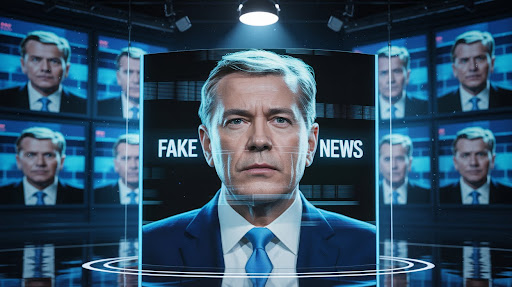Political Deepfakes: A New Threat to Democracy

Political deepfakes are now seen as a significant threat to democracy and trust in recent years. Known as deepfake, these extremely lifelike yet completely synthetic videos and audio files are being utilized to sway popular opinion, misinform, and even affect the outcome of elections. Although deepfake technology began as a novelty, it has currently turned into a tool of aggression to malicious users- particularly when applied in the political field.
What are Political Deepfakes?
Political deepfakes are artificial intelligence-based videos or audio files, in which politicians or other public people are depicted as saying or doing things that they have never said or done. They may involve such things as false speeches, as well as bogus scandals, edited interviews, or falsified endorsements. Using AI-powered deepfakes, voice cloning, facial expression mimicking, and lip syncing movements can be reproduced to the point where the resulting product seems almost indistinguishable form real life.
The Emergence of Political Deepfake Frauds
With election seasons coming in in various regions around the globe, political deepfake scams have also been observed to be on the increase. The scams are also usually accompanied by bigger disinformation campaigns. As an illustration, a deepfake video could depict a candidate saying something racist, admitting to committing crimes, or declaring falsely policy stances. When such a video becomes viral, the damage is usually done- even when they are later confirmed to be fake.
Voters in India, the U.S., and parts of Europe have already witnessed deepfake videos of political leaders. Others of these clips are used to start riots, influence voters, or even to distort opponents. Such practices do not only damage individual reputations but also reduce confidence in the democratic processes.
The Process of Making AI-Generated Deepfakes
In the past, making a deepfake required advanced technical skills, but currently, it is far simpler to do with readily available open-source AI applications. The advent of machine learning algorithms, such as GANs (Generative Adversarial Networks) has made political deepfakes producible by nearly anyone with a good computer. They work with hundreds of images or videos of an individual and can then create new, synthetic media that replicates their facial features, voice and gestures.
Even scarier is the fact that certain AI applications can be accessed freely online, which means it does not take a significant effort to encourage bad actors to create lifelike AI-powered deepfakes and weaponize them in political fights.
The Significance of Deepfake Detection
As this threat continues to expand, political deepfake detection has become a priority to governments, social media companies, and cybersecurity companies. Methods of detection vary, with methods analyzing inconsistencies in pixels and unnatural blinking patterns to neural networks trained to detect synthetics.
In spite of these achievements, it remains a difficult task to detect deepfakes. A lot of them are created to evade detection systems and with an advance in the technology, they become better at deceiving humans and machines alike.
The Place of Deepfake Rules
The world government is starting to comprehend the necessity of enacting effective deepfake laws. Legislators in nations, such as the U.S., China, and the EU, are advocating policies to criminalize malicious deepfake usage, particularly in politics. Enforcement is however an issue.
The legislature in the U.S has enacted laws in some states prohibiting the use of political deepfakes 30 days before an election. China has taken stringent measures in enforcing the use of watermarks and disclosures whenever using AI-generated media. The AI Act is also meant to present a number of safeguards against AI being used in deceitful ways, such as political deepfakes, introduced by the EU.
Yet, it is not enough to have legislation. Social media companies such as Facebook, YouTube, and X (previously Twitter) should also bear some responsibility, as they should flag or delete deepfake content within a short period. The battle against political deepfakes will be difficult without the cooperation among governments, technology companies, and civil society.
Psychological Effect on the Voters
The potentially most harmful feature of political deepfakes is that they lead to confusion and polarization. When such a fake video is released into the wild, it becomes highly viral on social media. Although it might be later identified as false, the first emotion-driven reaction might affect voting or the beliefs of people.
And it is not manipulation with people of only one country or political party- it is a worldwide problem that impacts on the democratic principles, the trust of people, and the credibility of news media. Deepfake detection scams are carried out to target human psychology and appeal to fear, anger, and outrage.
What Can Be Done to Guard Against Political Deepfakes?
The following are some of the means to ensure that you and your community are not victimized by political deepfake scams:
Before you post – Check the validity of viral political videos with reputable news websites and fact-checking websites.
Get educated – Visual distortions, unnatural lip syncing, or inconsistent lighting are possible givesaways of a deepfake.
Position statements – Push to have stricter regulations on deepfakes and hold platforms liable.
Spread media literacy – Teach friends and relatives about the presence and threat of AI-generated deepfakes.
Conclusion
Political deepfakes pose one of the greatest dangers to democracy in the digital era. Although the technology operating them is intriguing, it cannot be denied that it can be used to harmful effects. With a new age of political communication upon us, it is incumbent upon us to provide the means, expertise, and legal means by which to detect and counter deepfake manipulation. Then only, we can keep the integrity of our elections and the faith of the people.



